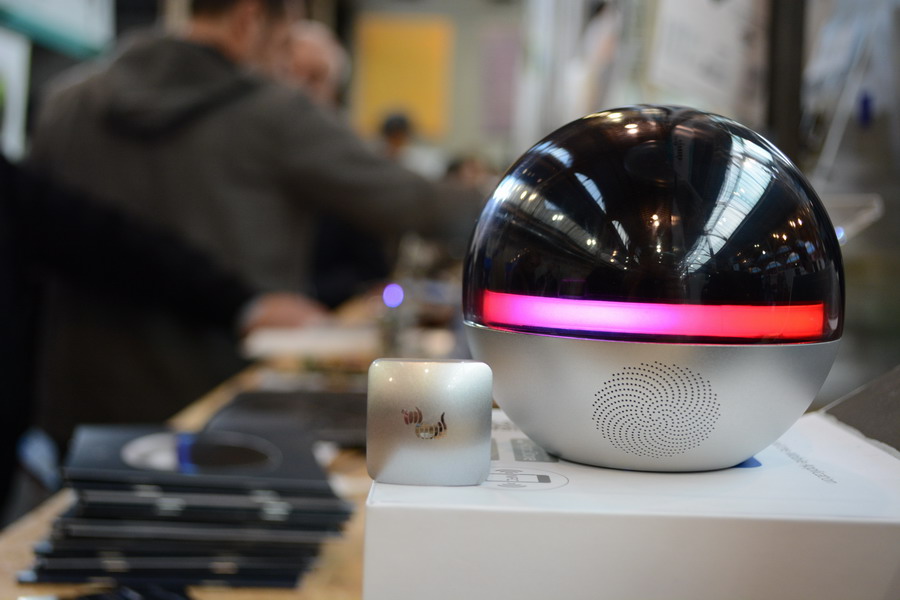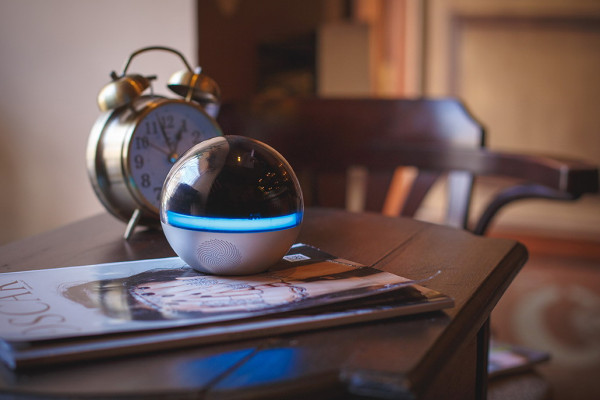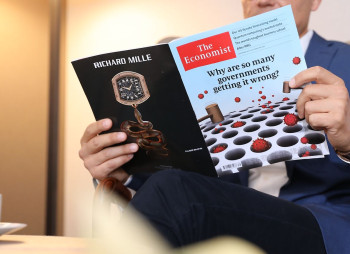In the beginning of this year Branto Company introduced a smart home device at the Consumer Electronics Show, which took place in the United States; a lot of the publications featured articles about the product. However, the new age device is not on the market yet. We decided to meet with the company founders Yosef Mets and Nick Bogun and learn the product’s story.
Branto is a smart home of the future, which intellect and hands are the remote presence robot. It is not just a device. It is a new lifestyle; and that is what we offer. It already can create an interactive environment for its owner, opening up new opportunities in the control of the appliances, monitoring the events at home, and providing the home security. Branto is unique because of giving the opportunity of visually teleportation and communications through 360͒ camera, microphones and speakers.
Yosef Mets: “The idea behind the project came after I bought a new house for myself. Then I thought for the first time about the smart home system for it. At that time such solutions were only beginning to appear among the technologically advanced and wealthy enthusiasts. As it turned out the full system would cost me over $50 thousands. And there I have decided that I would create my own smart home, which would be affordable for everyone.”
.jpg)
Yosef Mets, Brantos co-founder and CEO
“I tried to imagine what kind of solution would be included in it. A principle concept of device seemed relatively easy; for its creation all that was needed were signal retransmitters which commands would be understood by smart home devices and remote control. For the place of the remote control a person could use any smartphone. I thought of the realization details, which would easily be put together as a puzzle. Fortunately, the asked $50 000 by the integrator companies were falling out of this equation.”
“As a software projects manager, I quickly thought of how to create a realization of this solution. Through my partner from another startup I got introduced to Nick Bogun, who at that time was working at the ‘Walking Robot’ project that included parking automation. So I met with him to learn his opinion whether it was at all possible. Nick said: ‘there is nothing impossible’”
“After the conversation, for a few months I was thinking of different methods of realization and carefully studied solutions that were already on the market. The thought that I was on the right path was getting stronger and at some moment I realized that it was time for action. Nick and I met again and decided to start working.”
Nick Bogun: “November 2010 is considered to be the official birth date of Branto. We started with the feature set that would be controlled by a single hub. A developed prototype of the system was in a separate suited room; in it you could use a phone to open a lock, turn on/off lights, control AC, TV, and other appliances. The system worked and it was really cool. IT specialists embedded first set of commands in the system. When a person left the room and pressed ‘I left’ button, the lights and AC turned off, and the lock locked.”
.jpg)
Nick Bogun, Brantos co-founder and CTO
Yosef: “From the very beginning we decided for ourselves the key postulates to the design of the smart home that are still used. Nowadays, many smart home development companies think that the smart home hub is the end product. What is a smart home hub? The retransmitter for the wireless control of devices and nothing more. Branto’s concept is that the smart home should include the right user functional package (videocommunications, TV and media center control.)”
“First we put a camera inside the device. When trying the stationary camera, we realized that that wasn’t a solution. The user needed to have a chance to see everything with a 360 degree angle. We also put an IR blaster. With every new prototype the concept of Branto was becoming more obvious. Now it reminds more a house robot.”
“Testing and continued equipping of the room lasted about a year. During that time the team members included five people. All those engineers are all still working. The new engineers that came are still very inspired by the project to this day and they are the heart and soul of the Branto team.”
“Nowadays Branto team if consisted of professionals united by one mission. To unite the team around the mutual project turned out to be easy. It was harder to find hardware engineers, who could create the embedded electronics. However, when the guys found themselves in the working atmosphere with the product meant for the mass market, they were becoming involved and a part of the product and worked to their full potential.”
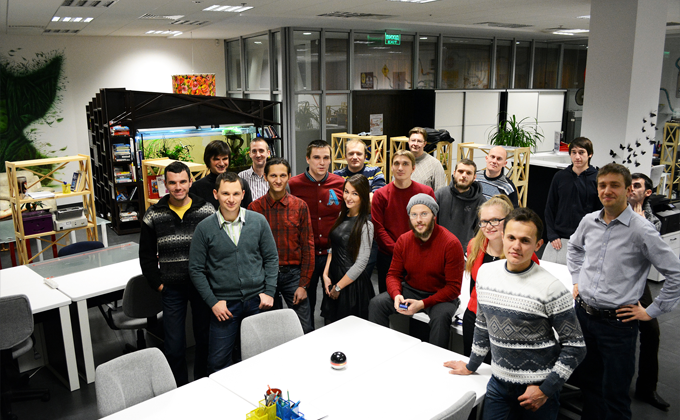
Branto team
“The main team was developing during a year. Even though we were not specifically looking for the engineers, most of them came to us with Nick. Those were colleagues from previous projects and very promising students. Correlation was very good. We were becoming known very fast even though no one really understood what smart home was.”
“After the last round of investments Branto team grew. At the start we formed a center where each person was responsible for the own work. We call this center a company’s ‘DNA’. That is exactly the foundation on which we are going to continue building our business. There people are devoted to the company and are concerned about its future.”
Nick: “Branto team includes engineers, many of whom gained the unique experience exactly here. They don’t feel limited and find unique solutions. These solutions I call creative courage. Engineers at Branto do not know the word ‘impossible’ or ‘this had been created before’. They do how they want to see it, and as the result we get something innovative.”
“The product’s development team is 20 people now, not counting outsourcers and interns. Team growth is sometimes organic; different specialists come to us with obvious interest, and we choose the ones who really need. However, team growth is doesn’t always mean effectiveness; mostly opposite. That is why we are trying to keep the original team to the moment the company comes to market.”
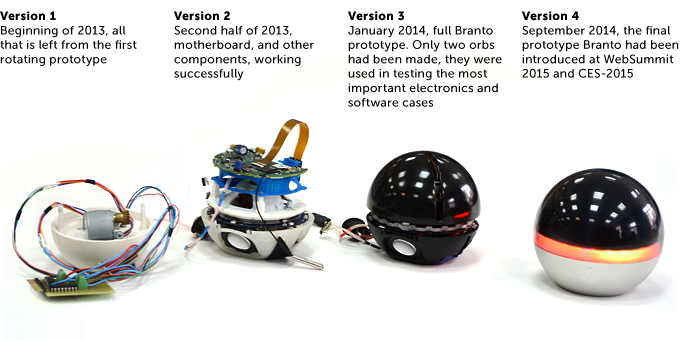
Brantos evolution
“In the first prototype of Branto IRblaster was the key element, with which house appliances could be controlled. We also created the entire set of sensors controlled by ZigBee (wireless protocol between devices with low energy usage.) It was the first working release of Branto Smart Home. For a long time we were playing with this version and tested it on our visitors. Later came a realization that we want something more than just control of the peripheral of the house. We wanted to create a device that would truly capture a user and become a trend like iPhone but among smart homes. That is when it was decided to add rotating camera, create our motherboard and add speakers and microphone.”
“Work on the motherboard deserves a separate story. This move was inspired by Nest. We were constantly buying innovation in electronics, opened them up and carefully studied them. All in all we realized that if we wanted to become a serious company, than we had to have a unique product created with unique technologies. Of course it is possible to create a great product from the ready materials, but it would probably not become serial manufacturing product due to high production cost. We put effort on producing a motherboard from scratch in the original design.”
“Branto was constantly changing; on the inside and on the outside. At first it was small. Then the orb grew to the size of 101mm filled up with electronics. Now you can find a battery, GSM module, FullHD video camera (right now we in the process of integration).”
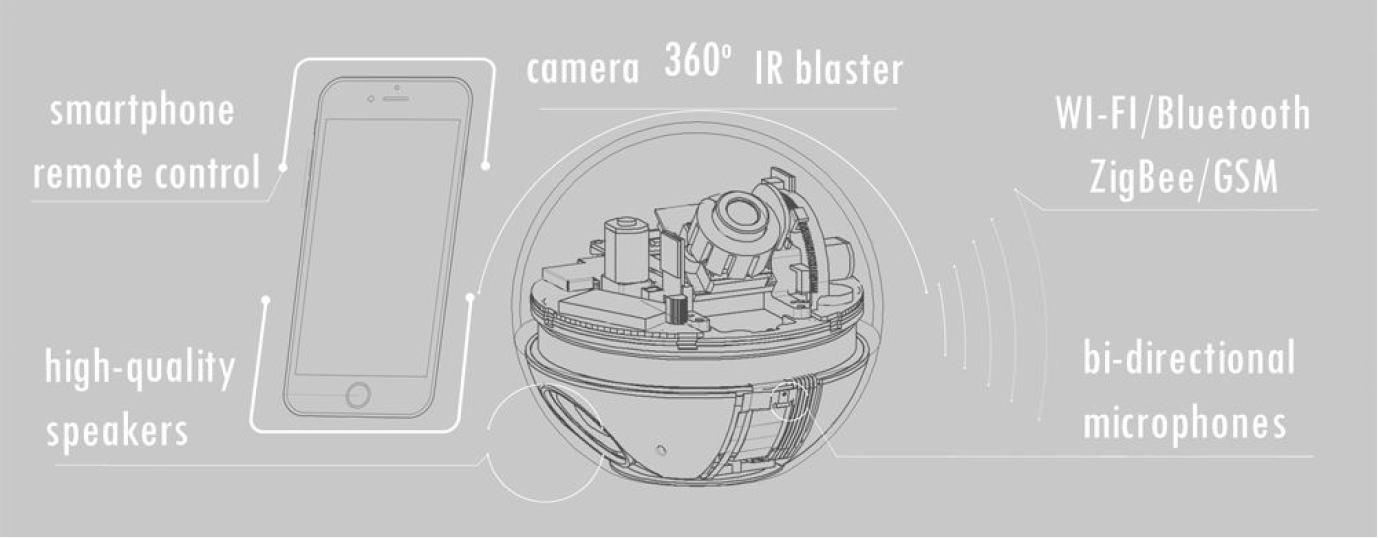
“The device is automated: it can be at any moment taken to a different room or outside. In the active mode with nonstop video camera working, the battery can last for four hours. In the sleeping mode or light usage – up to 12 hours. Branto is not ready yet to be working for a long time without a charger, for the capacities liion batteries does not last long. However, the future is for fully automated and energy selfsufficientdevices, and we are following the innovations in that field.”
“The success of any product depends on the knowledge of the consumer demands. We constantly test the product on ourselves, our relatives and random people. The gained insights show that it is important to continue development on the first concept opportunities. Already Branto reminds an android head. We want future models of Branto to able to communicate with people even on an elementary level”.
Yosef: “Of course in the first place it has to do with aesthetics and nature etalons. However, we were also developing a device that had to control IR devices, such as AC, TV and others. That is exactly why we had design a unique solution, which could turn on technology at any direction and distance in the house. The consumer should not have to think about where and how he should place the device. What form best describes it? Sphere.”
“First Branto’s appearance is tied with a few events; Kickstarter crowdfunding campaign, CES 2015 (Las Vegas), and annual Hardware Battlefield hosted by TechCrunch. For us the results of the Kickstarter campaign were more than useful. We were able to capture the attention to our campaign and our product. We are still receiving letters every day. They are interested in Branto, offer partnerships and ask where it could be bought. And all of this considering that the crowdfunding campaign was over five months ago.”
“The full amount is $850K. We as founders invested $200K. The first angel investments we acquired in June 2013 were $150K. The second round was $500K from a businessangel in October the same year. All the acquired funds went to the product’s development and preparation for entering the market.”
“Today we are starting work on acquiring the next investment round. We developed a few business models for company’s growth. Moreover, we are growing the interest to the product from the end consumers, with whom we talk through our website, conferences, and social media. More and more people become fans of Branto and share with us their thoughts and expectations. Even though many of them would like to buy the product right here right now, we are not striving to get it to them right away. It has to go through the full cycle of testing and satisfy the mentioned before functionality. We see our product not as a small gadget for geeks, but as a product for mass market.”
“At the moment we have a company in the states, a registered trademark and have a few patent applications. As well as our team, all of that is our starting capital.”
In the future we plan to open the management office is Israel, and bring the R&D to SouthWest Asia, closer to the production facilities.
“First of all the company is oriented on the western market. Our main focus is on the United States and Canada. However, the offers we receive from different distributers show us that there is also a high potential in the European and Asian markets. We are nicely surprised with the volume of attention from Japan, Malaysia, Singapore, China. We did not expect such high interest from those markets in still developing niche of smart home devices. Today we are learning the possibilities of entering them.”
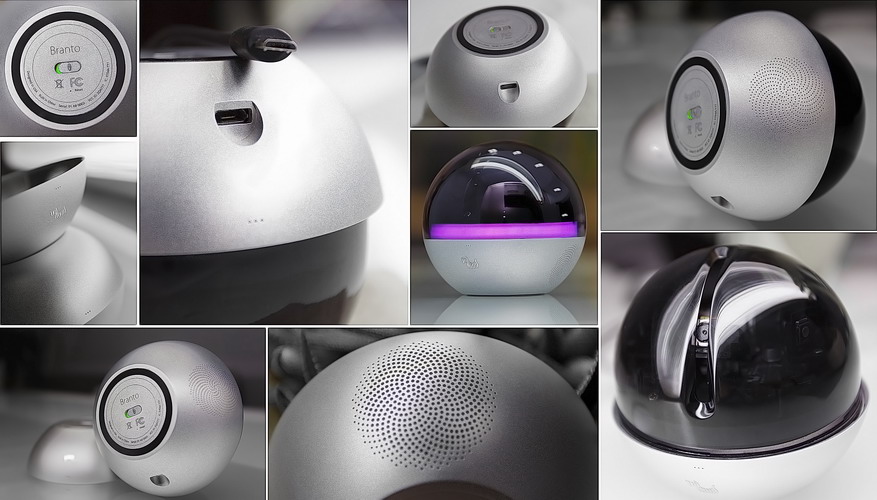
“Retailers from the CIS countries also have what to offer Branto. Already we have potential partners in Ukraine, Russia, Belarus and Kazakhstan. Of course the market volume there is not as impressive as in the USA, yet we are not going decline the opportunity to operate in the known to us market.”
“The developed monetary model is pretty versatile. We do not tie our future growth to sales. Many of our developments and technologies went beyond Branto itself and can become separate projects”.
“We are looking to get a part in one of the most perspective electronics markets: Internet of Things (IoT), which world’s volume will be 1.7 trillion in 2019 according to IDC experts. Our segment on this market is smart home solutions niche. The sales volume for the hubs in USA and Canada could be up to 2.75 million this year, while connected devices, fully automated or working through hub, are up to 30 million units.”
“Many electronics producing companies, such as Apple, Google and Samsung, are working on their own smart home solutions. However, the big companies projects are often not effective and expensive. That is exactly why such companies are paying more attention to acquiring promising startups. In 2014 Samsung acquired SmartThings startup, and an affiliated Google company took over Nest, a thermostat developing company. The sum of the last deal was $3.2B. That acquisition was the largest one last year. Today there are many deals like that. No one really know what product is going to be successful. The ‘smart home’ market is opened to unlimited opportunities for all who works in that field; any one can become next Google or Apple.”
Nick: “Branto’s future is the home robot. We already are designing it as a selflearning device. Builtin camera and bidirectional microphones open up possibilities to sound and silhouette recognition. The way to control smart home today is through smartphone and touch pad, which is not the limit. In the future we would like to give people the opportunity to control smart home intuitively or without even touching the controls. Users should not be worrying about different trivia; they better focus more and creativity and themselves. The house has to help them with that, making people’s lives easier. That is one of our main ideas.”
Yosef: “Any event in our home of the future has to guess desires or the intentions of its inhabitants. For example, recognize owners, watch after their day rutine, serve them, and control other processes. The house can do the simplest things, but all of it especially for the person.”
“You can’t imagine a better house that people take care of. Today not many people can afford such service. Imagine that in each of our lives will appear a smart assistant, which would work unnoticeably, never slept or rested. There is the ideal of our Home of the Future.”

Interview was held by Mila Lerner / InVenture Investment Group



